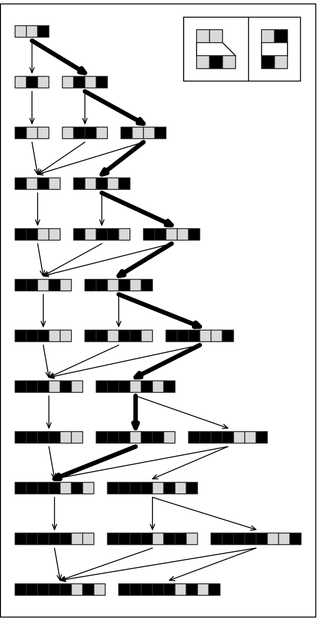But one might imagine that across the much broader range of computational systems that I have considered in this book—and that presumably occur in nature—there could nevertheless still be great differences in the rates at which given computations can be done.
Yet from what we saw in Chapter 11 one suspects that in fact there are not. For in the course of that chapter it became clear that almost all the very varied systems in this book can actually be made to emulate each other in a quite comparable number of steps.
Indeed often we found that it was possible to emulate every step in a particular system by just a fixed sequence of steps in another system. But if the number of elements that can be updated in one step is sufficiently different this tends to become impossible.
And thus for example the first picture below shows that it can take t2 steps for a Turing machine that updates just one cell at each step to build up the same pattern as a one-dimensional cellular automaton builds up in t steps by updating every cell in parallel.
And in d dimensions it is common for it to take, say, td + 1 steps for one system to emulate t steps of evolution of another.
But can it take an exponential number of steps? Certainly if one has a substitution system that yields exponentially many elements then to reproduce all these elements with an ordinary Turing machine will take exponentially many steps. And similarly if one has a multiway system that yields exponentially many strings then to reproduce all these will again take exponentially many steps.
But what if one asks only about some limited feature of the output—say whether some particular string appears after t steps of evolution of the multiway system? Given a specific path like the one in the second picture below it takes an ordinary Turing machine not much more than t steps to test whether the path yields the desired string.
But how long can it take for a Turing machine to find out whether any path in the multiway system manages to produce the string? If the Turing machine in effect had to examine each of the perhaps exponentially many paths in turn then this could take exponentially many steps. But the celebrated P=NP question in computational complexity theory asks whether in general there is some

To emulate t steps in the evolution of the cellular automaton takes the Turing machine 2t2 + 5t - 6 steps.

A Turing machine can quickly test the highlighted path but could take exponentially long to test all paths.



